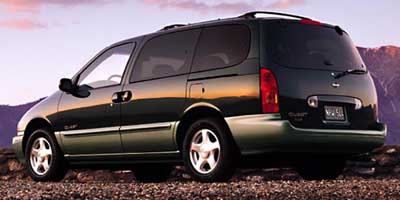New Car/Review

1999 Nissan Quest GLE
by John Heilig
SPECIFICATIONS
MODEL: Nissan Quest GLE
ENGINE: 3.3-liter SOHC V-6
HORSEPOWER/TORQUE: 170 hp @ 4800 rpm/200 ft-lbs @ 2800 rpm
TRANSMISSION: Four-speed automatic
FUEL ECONOMY: 17 mpg city, 24 mpg highway, 16.8 mpg test
WHEELBASE: 112.2 in.
LENGTH x WIDTH x HEIGHT: 194.8 x 74.9 x 64.2 in.
CURB WEIGHT: 3986 lbs.
FUEL CAPACITY: 20.0 gal.
LUGGAGE CAPACITY: 57.5 to 111.3 cu. ft.
TIRES: P215/70R15
INSTRUMENTS: Speedometer, tachometer, fuel gauge, water temperature, digital clock.
EQUIPMENT: Power windows, power door locks, power mirrors, cruise control, air conditioner, AM-FM stereo radio with in-dash cassette player, anti-lock brakes, dual front air bags.
STICKER PRICE: $26,819
Minivan manufacturers keep changing their offerings to differentiate their products from all the other minivans on the market. For Nissan, the Quest gives them an opportunity to also make some changes to the basic minivan format. Some of the changes make sense, some make less sense than others.
One innovation that makes sense is a movable shelf located behind the rear seat. Why does that make sense? When you go shopping, the probability is that youíll stick the packages behind the rear seat. If you do a lot of shopping, youíll soon run out of area, but you wonít run out of volume. Nissanís solution is to put that shelf in the back so you can "stack" the packages. Itís a nice touch.
The removable shelf makes it difficult to carry large objects back there. Yes, I know I said itís removable, but when we had a half dozen large pictures to carry it was easier to put them in the aisles between the banks of seats that it was to remove the shelf.
Nissanís other innovation, and something that Oldsmobile has tried with the Silhouette Premiere, is to install a video player. This is a video cassette player/television to "entertain the kiddies" or restless adults during long rides. But where Oldsmobile mounts the video screen so it swings down from the ceiling, Nissanís is mounted in the back of a console between the front seats.
As far as visibility for passengers in the second row bench, itís great. Passengers in the third row bench will have difficulty seeing the screen.
The critical disadvantage as far as I was concerned, though, was that this console blocks the passage between the front seats, eliminating access to the rear seats from the front. I have always felt that this was one of the major advantages of vans, both mini and maxi, and it was disappointing to see this area blocked off. That was always one of my major complaints with the Toyota Previa. So while I applaud the idea of an entertainment center, there should be a better location for it.
You donít really have a console there either. It contains one cupholder and thatís it, no storage area. There are dual cupholders that swing out from the dash that are as practical as the single cupholder in the console.
Quest is powered by a 3.3-liter 170 horsepower V-6 mated to a four-speed automatic transmission with a column-mounted shifter. Power is more than adequate. There was no time when I felt I wanted more power and there were a couple of times in rainy weather when I chirped the tires. So performance of the Quest was un-Quest-ionable (sorry).
We had a good sound system with the Quest that included an AM/FM stereo radio with an in-dash cassette player. Volume and station changer controls were located on the steering wheel hub, as were cruise control switches, making them all convenient.
Nissanís Quest is a worthy competitor in the minivan field. It has some advantages over the others, such as the shelf. It has disadvantages, such as the entertainment center that blocks the passage between the front seats.
I think Nissan has it right and needs just a few slight modification to make the Quest work.


